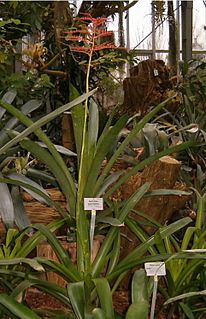This page is based on this
Wikipedia article Text is available under the
CC BY-SA 4.0 license; additional terms may apply.
Images, videos and audio are available under their respective licenses.

The Primulaceae are a family of herbaceous and woody flowering plants with about 53 genera with 2790 species, including some favorite garden plants and wildflowers, commonly known as the primrose family. Most Primulaceae are perennial though some species, such as scarlet pimpernel, are annuals. The family has been variously circumscribed, but it is now accepted in the broad sense including the former families Myrsinaceae and Theophrastaceae, because many genera traditionally placed in Primulaceae were found to belong to those other families and when united their circumscription remains intact.

Puya is a genus of the botanical family Bromeliaceae, subfamily Pitcairnioideae. These terrestrial plants are native to the Andes Mountains of South America and southern Central America. Many of the species are monocarpic, with the parent plant dying after one flower and seed production event.

Bromelia is the type genus of the botanical family Bromeliaceae, subfamily Bromelioideae. Bromelia species are widespread across much of Latin America and the West Indies, and are characterized by flowers with a deeply cleft calyx. The genus is named after the Swedish medical doctor and botanist Olof Bromelius (1639-1705).
In biology, a homonym is a name for a taxon that is identical in spelling to another such name, that belongs to a different taxon.

Vriesea is a genus of the botanical family Bromeliaceae, subfamily
Tillandsioideae. The genus name is for Willem Hendrik de Vriese, Dutch botanist, physician (1806–1862). Its species are widespread over Mexico, Central America, South America and the West Indies.

Aechmea is a genus in the botanical family Bromeliaceae, subfamily Bromelioideae. The name comes from the Greek aichme. Aechmea has eight subgenera and 255 species distributed from Mexico through South America. Most of the species in this genus are epiphytes.

Deuterocohnia is a genus of the botanical family Bromeliaceae, subfamily Tillandsioideae, endemic to South America. The genus is named for Ferdinand Julius Cohn, Jewish botanist and bacteriologist.
Pothuava is a subgenus of the genus Aechmea.

In taxonomy, an undescribed taxon is a taxon that has been discovered, but not yet formally described and named. The various Nomenclature Codes specify the requirements for a new taxon to be validly described and named. Until such a description has been published, the taxon has no formal or official name, although a temporary, informal name is often used. A published scientific name may not fulfil the requirements of the Codes for various reasons. For example, if the taxon was not adequately described, its name is called a nomen nudum. It is possible for a taxon to be "undescribed" for an extensive period of time, even if unofficial descriptions are published.

Dyckia is a genus of the botanical family Bromeliaceae, subfamily Pitcairnioideae.

Pitcairnia is a genus of the botanical family Bromeliaceae, subfamily Pitcairnioideae. It was named for Dr. William Pitcairn, English physician and gardener (1711-1791). The genus Pitcairnia ranks as the second most prolific of the bromeliad family. They are most abundant in Colombia, Peru and Brazil, but can also be found in areas from Cuba and Mexico south to Argentina. One species, Pitcairnia feliciana is found in tropical West Africa and is the only member of the Bromeliaceae family not native to the Western Hemisphere.

Racinaea is a genus of the botanical family Bromeliaceae, subfamily Tillandsioideae. The genus is named for Racine Foster, wife of Mulford B. Foster and co-founder of the BSI
Stylogyne is a genus of shrubs and trees in the family Primulaceae. Its members are found throughout tropical parts of the Americas, with the greatest diversity in South America. It is closely related to the genera Ardisia and Geissanthus, and various species have been transferred between the three genera. All three were formerly placed in the family Myrsinaceae, which is now treated as a subfamily (Myrsinoideae) of the Primulaceae.
Nomen illegitimum is a technical term, used mainly in botany. It is usually abbreviated as nom. illeg. Although the International Code of Nomenclature for algae, fungi, and plants uses Latin terms for other kinds of name, the glossary defines the English phrase "illegitimate name" rather than the Latin equivalent. However, the Latin abbreviation is widely used by botanists and mycologists.
Billbergiopsis is a subgenus of the genus Quesnelia and contains 15 of the 20 described species of the genus.









